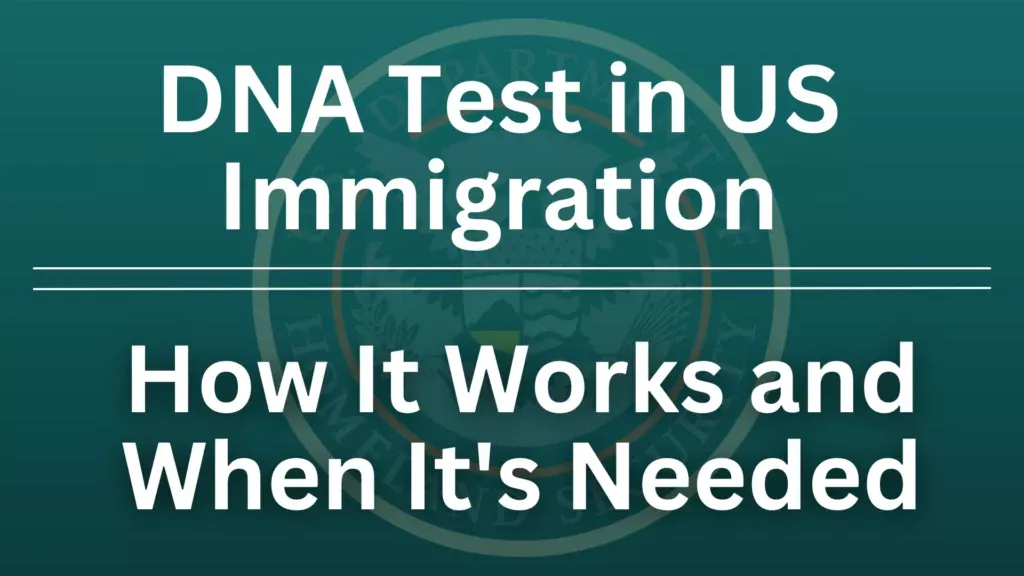It is difficult for an immigrant to join their family living in the United States.
It can be challenging to prove your relationship and sometimes the usual paperwork isn’t enough.
DNA testing is used to verify the relationships.
This test can show if you’re biologically related to someone in the US, making the immigration process smoother.
When is DNA Testing Required?
The US Citizenship and Immigration Services (USCIS) uses DNA testing to confirm the biological relationship in some cases where generally using proof, like birth certificates, isn’t available or good enough.
Some common situations where DNA testing might be needed:
- Incomplete or Missing Documentation: In conditions like war, natural disasters, etc… in your home country, it becomes difficult for an applicant to get the usual documents to prove your family connection. In such conditions, DNA testing can be a reliable option. Even if someone lost their birth certificate or other papers are lost, DNA testing can provide proof of your family relationship.
- Adoption: If an applicant was adopted as a child, they might need DNA testing to prove their biological relationship with a US citizen parent. This evidence could support their immigration application.
- Questionable Paternity: When the father is not named on a birth certificate or paternity is in question, DNA testing provides a definitive way to establish the biological relationship.
Initiating the DNA Testing Process
It’s important to understand that applicants cannot initiate DNA testing for immigration purposes on their own.
The authority to request DNA testing lies exclusively with the US embassy or consulate, USCIS, or a domestic passport agency responsible for processing the application.
They will recommend a laboratory accredited by the American Association of Blood Banks (AABB) to ensure the test’s accuracy and adherence to strict chain-of-custody protocols.
Procedure
The immigration DNA testing process is tightly controlled to ensure result integrity, unlike commercial services.
Steps:
- Embassy/Consulate Action: The US embassy or consulate handling the application will provide a DNA test kit directly from the AABB-accredited lab. Applicants cannot choose their own lab or make independent arrangements for testing.
- Sample Collection: Officials at the embassy/consulate will witness the DNA sample collection, typically through a buccal swab (inner cheek scrape). They will then ensure proper packaging and shipment of the sample directly to the AABB lab, following strict chain-of-custody procedures to eliminate any possibility of tampering.
- Laboratory Analysis: The AABB-accredited lab will conduct the DNA test and analyze the results.
- Result Reporting: The lab will forward the results directly to the US embassy or consulate, not to the applicant themself.
Relationships Tested in Immigration DNA Tests
Standard DNA tests used for immigration purposes can establish the following biological relationships:
- Parent-Child Relationship: This test confirms the biological link between a parent and child.
- Full Sibling Relationship: This test determines whether two individuals share biological parents.
- Half-Sibling Relationship: This test establishes if two individuals share one biological parent.
It’s important to note that USCIS does not accept DNA tests for more distant relationships, such as aunts, uncles, or cousins.
Confidentiality and Privacy
USCIS prioritizes the privacy of individuals undergoing DNA testing. Strict confidentiality regulations bind the AABB-accredited labs.
DNA samples are typically stored for a limited period as mandated by USCIS and then destroyed.
Considering DNA Testing for Your Application
While DNA testing can be a valuable tool in certain situations, it’s essential to consult with an immigration attorney specializing in family petitions.
They can advise you on the likelihood of USCIS requesting DNA testing in your case and guide you through the application process.
Remember, DNA testing can be a time-consuming and potentially expensive step.
Understanding when and how it’s used within the US immigration system can help you navigate this complex process effectively.
Source: travel.state
